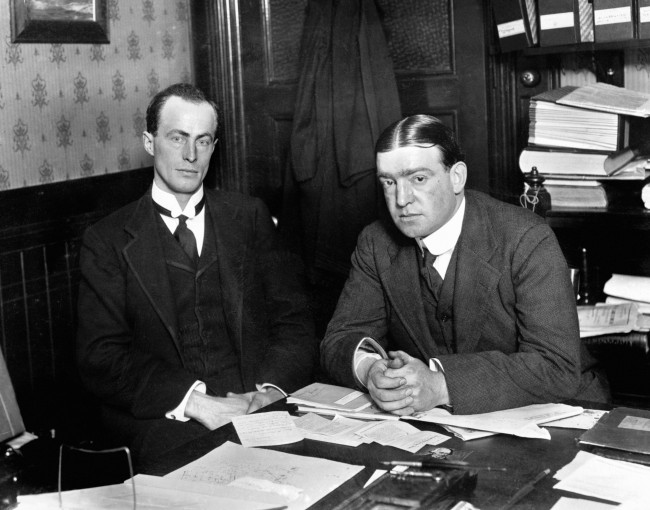The Guardian’s Reporting On The Akademik Shokalskiy Is Selective, Biased And Hilarious

Dr Douglas Mawson, an Australian explorer with fellow Antarctic explorer, Dr Ernest Shackleton.
Date: 01/01/1907
GUARDIAN journalists Alok Jha and Laurence Topham were onboard the trapped Akademik Shokalskiy, the ship occupied by University of New South Wales climate scientists looking for signs of global warming but found only ice.
How did the paper report on the laugh-in?
January 3 2013: Bridle Jabour makes not one mention of global warming nor climate change in his article. We hard from Jha: “To the crew of Aurora Australis and Xue Long – heartfelt thanks from all on the Shokalskiy. We know how far out of your way you all went.”
On the “Antarctica Live” blog, Jha had breaking news: The Antarctic is cold!
Antarctica is not just cold, windy and wet. It is the extreme of all those things. Leave a hole in your armour – a glove not tucked into a sleeve, a gap around your neck where you forgot your scarf – and the weather will find and punish you fast. The cold starts off as stabbing, then it sears the skin and eventually sends the nerve-endings into a symphony of confusion. I took a glove off to type an email outside at one point and, after my fingers turned white and I lost the ability to move them, I swear they felt hot. Painful, boiling hot, as though I had just plunged them into a cup of coffee.
This is supported by Oliver Milman who tells Guardian readers:
Five basic Antarctic facts for climate change sceptics
1. It is large and cold
You want more? OK:
2. It is not the same as the Arctic
On December 11, Jha makes a breakthrough:
Realising that the multiple-layer specially-chosen technical fabrics all did what they said on the label. I was warm and windproof for a long time out on deck, even as the wind and rain raged.
Humanity is great. Let’s hear it for plastics. Things like:
HyVent™ fabric is used by The North Face in many of its winter garments. It’s an applied PU (PolyUrethane) coating which adds durability and comfort, while also providing dependable waterproof fortification in cold and wet
Technology is marvellous. Notes Topham:
It’s an amazing feeling. The helicopter ride was quite thrilling … I had this amazing view. We shot up and it it was just extraordinary. The scene was so beautiful. There was beautiful light across the ice. Having been trapped in this boat for the past 10 days or so and then suddenly be hoisted out of it … was mesmerising.
Oliver Milman explains that the truth is not that simple.
To some climate change contrarians, repeated attempts to free the vessel from the ice are proof that the theory of climate change is flawed or, at best, exaggerated. After all, a warming planet has no ice at all, right? …
There are still gaps in scientific understanding of the Antarctic, mainly around the dynamics of ice sheets. This understanding will be improved by rigorous analysis of gathered evidence. It’s unlikely a single ship getting stuck in ice will cause a major deviation in researchers’ findings.
And then this:
Temperature rises resulting from unchecked climate change will be at the severe end of those projected, according to a new scientific study.
Oh?
The scientist leading the research said that unless emissions of greenhouse gases were cut, the planet would heat up by a minimum of 4C by 2100, twice the level the world’s governments deem dangerous.
We are all shafted.
The research indicates that fewer clouds form as the planet warms, meaning less sunlight is reflected back into space, driving temperatures up further still. The way clouds affect global warming has been the biggest mystery surrounding future climate change.
Professor Steven Sherwood, at the University of New South Wales, in Australia, who led the new work, said: “This study breaks new ground twice: first by identifying what is controlling the cloud changes and second by strongly discounting the lowest estimates of future global warming in favour of the higher and more damaging estimates.”
“4C would likely be catastrophic rather than simply dangerous,” Sherwood told the Guardian. “For example, it would make life difficult, if not impossible, in much of the tropics, and would guarantee the eventual melting of the Greenland ice sheet and some of the Antarctic ice sheet”, with sea levels rising by many metres as a result.
And this this gem:
The research is a “big advance” that halves the uncertainty about how much warming is caused by rises in carbon emissions…
The Guardian makes no mention of the stricken ship in that doom-laden article. Wonder why..?
As Jah notes: “We’ve reached the end of the world: Antarctica.”
We’re all doomed.
Posted: 3rd, January 2014 | In: Reviews Comments (3) | TrackBack | Permalink


